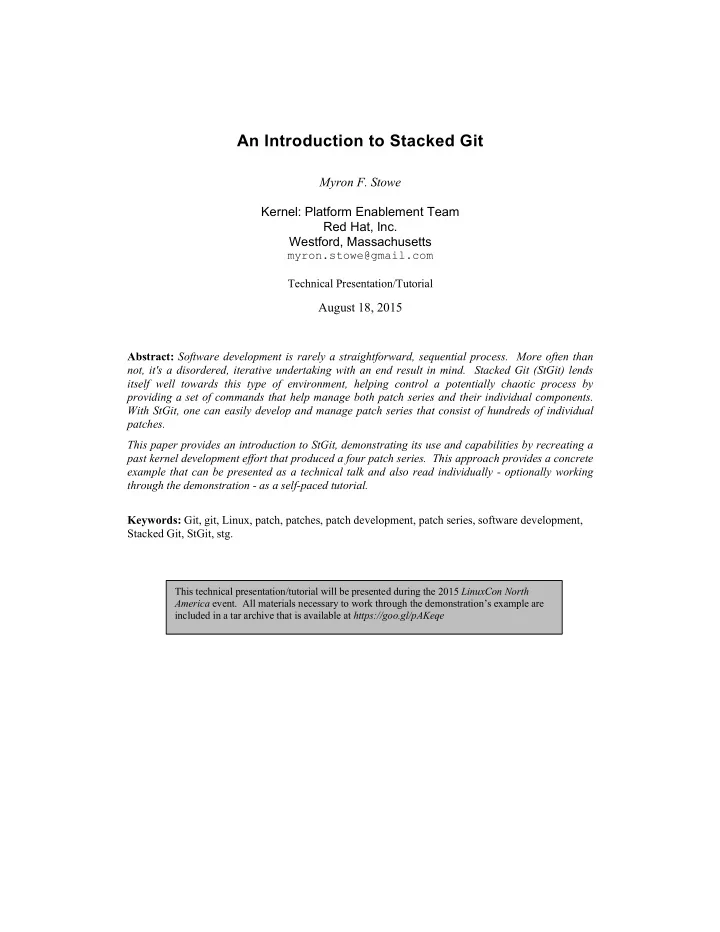

An Introduction to S tacked Git Myron F. Stowe Kernel: Platform Enablement Team Red Hat, Inc. Westford, Massachusetts myron.stowe@gmail.com Technical Presentation/Tutorial August 18, 2015 Abstract: Software development is rarely a straightforward, sequential process. More often than not, it's a disordered, iterative undertaking with an end result in mind. Stacked Git (StGit) lends itself well towards this type of environment, helping control a potentially chaotic process by providing a set of commands that help manage both patch series and their individual components. With StGit, one can easily develop and manage patch series that consist of hundreds of individual patches. This paper provides an introduction to StGit, demonstrating its use and capabilities by recreating a past kernel development effort that produced a four patch series. This approach provides a concrete example that can be presented as a technical talk and also read individually - optionally working through the demonstration - as a self-paced tutorial. Keywords: Git, git, Linux, patch, patches, patch development, patch series, software development, Stacked Git, StGit, stg. This technical presentation/tutorial will be presented during the 2015 LinuxCon North America event. All materials necessary to work through the demonstration’s example are included in a tar archive that is available at https://goo.gl/pAKeqe
Table of Contents Introduction ........................................................................................................................................................................... 1 ¡ Overview ............................................................................................................................................................................... 1 ¡ ............................................................................................................................................................................... 2 ¡ Workflow Creating a Topic Branch ........................................................................................................................................................................ 2 ¡ Creating Patches ..................................................................................................................................................................................... 3 ¡ ............................................................................................................................................ 4 ¡ Manipulating Patch Ordering on the Stack ........................................................................................................................................................... 5 ¡ Exporting and Importing Patches Splitting a Patch into Multiple Patches .................................................................................................................................................. 6 ¡ ...................................................................................................................................... 7 ¡ Cleaning Up the Series for Public Submission .......................................................................................................................................................................... 7 ¡ Rebasing a Patch Series Submitting Patches Upstream ................................................................................................................................................................ 7 ¡ Removing the Topic Branch .................................................................................................................................................................. 7 ¡ Reference Material ................................................................................................................................................................ 8 ¡ .......................................................................................................................................................................... 8 ¡ Bibliography .................................................................................................................................... 9 ¡ Appendix A Example’s Patch Series A.1 commit 8546713 ..................................................................................................................................................................... 10 ¡ A.2 commit fff0ee3 ..................................................................................................................................................................... 11 ¡ A.3 commit c5081cd ..................................................................................................................................................................... 12 ¡ A.4 commit 6f2729b ..................................................................................................................................................................... 16 ¡ ii
An Introduction to Stacked Git Introduction “StGit is a Python application 1 providing similar functionality to Quilt (i.e. pushing/popping patches to/from a stack) on top of Git. These operations are performed using Git commands and the patches are stored as Git commit objects, allowing easy merging of the StGit patches into other repositories using standard Git functionality. StGit is licensed under the GNU General Public License.”[1] “Note that StGit is not a source configuration management (SCM) interface on top of Git and it expects a previously initialized Git repository.”[1] As such, this tutorial assumes pre-requisite knowledge of Git's basics. StGit uses the same configuration mechanisms as Git. Reference man pages git(1) and git-config(1) for more details. For a full list of StGit commands: $ stg help For quick help on individual subcommands: $ stg help <cmd> For more extensive help on a subcommand: $ man stg-<cmd> Overview For demonstration purposes we'll utilize an existing patch series that Shuah Khan produced and submitted to the " linux- pci " mail list on 02.17.2013. [PATCH v2 0/4] pci: Add PCI_BUS() and PCI_DEVID() interfaces to return bus number and device id [PATCH v2 1/4] pci: Add PCI_BUS_NUM() and PCI_DEVID() interfaces to return bus number and … [PATCH v2 2/4] pci/aer: Remove local PCI_BUS() define and use PCI_BUS() from pci [PATCH v2 3/4] iommu/amd: Remove local PCI_BUS() define and use PCI_BUS() from pci [PATCH v2 4/4] iommu/amd: Remove calc_devid() and use PCI_DEVID() from pci The objective of the series was to re-factor multiple, private, instances of PCI_BUS() , along with a private instance of calc_devid() , into PCI_BUS_NUM() and PCI_DEVID() interfaces for use globally within the kernel ( see Appendix A ). Using this series, we'll re-enact a typical development workflow, including mistakes and moments of insight, acting as if we were developing the series ourselves from scratch. 2 As mentioned, StGit is not a stand-alone program; it operates on an existing Git repository that has already been created, using git init or git clone . As the series of interest was developed for the Linux kernel, we'll use a local kernel repository cloned from the kernel.org site. $ cd ~/temp/linux/ $ git remote -v origin git://git.kernel.org/pub/scm/linux/kernel/git/torvalds/linux.git (fetch) origin git://git.kernel.org/pub/scm/linux/kernel/git/torvalds/linux.git (push) 1 $ which stg /usr/bin/stg $ file /usr/bin/stg /usr/bin/stg: Python script, ASCII text executable 2 While the example comes from development efforts within the Linux Kernel project, StGit is applicable to any project that utilizes Git - including non-software related projects. 1
Recommend
More recommend